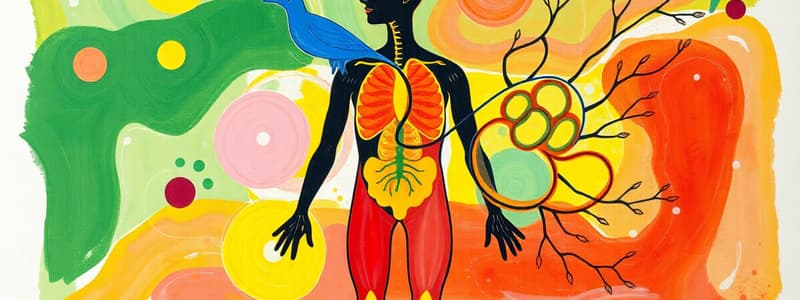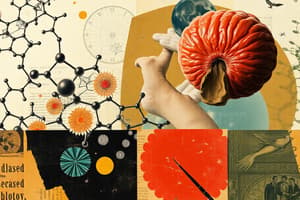Podcast
Questions and Answers
What is the primary purpose of homeostasis in the body?
What is the primary purpose of homeostasis in the body?
- To increase metabolic fluctuations
- To promote rapid adaptation to external stimuli
- To enhance the growth of organs
- To maintain a constant internal environment (correct)
Which of the following best describes homeostatic pathways?
Which of the following best describes homeostatic pathways?
- They ignore environmental changes.
- They only function during extreme conditions.
- They involve steps to return to a set point. (correct)
- They are constant and unchanging.
What is an example of a negative feedback loop?
What is an example of a negative feedback loop?
- Regulating body temperature (correct)
- Blood clotting process
- Oxytocin release during childbirth
- Changing heart rate in response to stress (correct)
Which component of a homeostatic pathway establishes the set point?
Which component of a homeostatic pathway establishes the set point?
Which of the following is NOT a factor that the body maintains in homeostasis?
Which of the following is NOT a factor that the body maintains in homeostasis?
What happens when the body temperature deviates from the set point?
What happens when the body temperature deviates from the set point?
Which physiological changes would result from a positive feedback loop?
Which physiological changes would result from a positive feedback loop?
What is the role of effectors in the homeostatic pathway?
What is the role of effectors in the homeostatic pathway?
What is the primary purpose of spermatogenesis?
What is the primary purpose of spermatogenesis?
Where does spermatogenesis occur?
Where does spermatogenesis occur?
What role does LH play in male reproductive health?
What role does LH play in male reproductive health?
Why is it advantageous for the testes to reside outside the body core?
Why is it advantageous for the testes to reside outside the body core?
Which of the following correctly outlines the path of sperm from production to ejaculation?
Which of the following correctly outlines the path of sperm from production to ejaculation?
During the ovarian cycle, what triggers the release of a mature egg?
During the ovarian cycle, what triggers the release of a mature egg?
What hormones are primarily involved in the regulation of sperm production in males?
What hormones are primarily involved in the regulation of sperm production in males?
What occurs to unused sperm after production?
What occurs to unused sperm after production?
What is the primary function of temperature sensors in the context of homeostasis?
What is the primary function of temperature sensors in the context of homeostasis?
Which best describes the role of the hypothalamus in homeostasis?
Which best describes the role of the hypothalamus in homeostasis?
Which statement accurately describes homeostasis?
Which statement accurately describes homeostasis?
Why is the body temperature typically maintained at around 37°C?
Why is the body temperature typically maintained at around 37°C?
What does negative feedback in the context of homeostasis refer to?
What does negative feedback in the context of homeostasis refer to?
In human reproduction, what do the terms 'haploid' and 'diploid' refer to?
In human reproduction, what do the terms 'haploid' and 'diploid' refer to?
What occurs after a haploid male gamete fertilizes a haploid female gamete?
What occurs after a haploid male gamete fertilizes a haploid female gamete?
Which of the following is an example of an effector involved in thermoregulation?
Which of the following is an example of an effector involved in thermoregulation?
What is the primary function of the uterine cycle?
What is the primary function of the uterine cycle?
At what stage in a female's life does oogenesis begin?
At what stage in a female's life does oogenesis begin?
Which hormones are responsible for the maturation of a follicle in the ovary?
Which hormones are responsible for the maturation of a follicle in the ovary?
What occurs during ovulation?
What occurs during ovulation?
Which hormone causes the thickening of the endometrium?
Which hormone causes the thickening of the endometrium?
What part of the brain is responsible for monitoring hormone levels like testosterone and estrogen?
What part of the brain is responsible for monitoring hormone levels like testosterone and estrogen?
What happens when menstruation occurs?
What happens when menstruation occurs?
Which hormone is produced by the ovaries as a consequence of FSH and LH action?
Which hormone is produced by the ovaries as a consequence of FSH and LH action?
What hormone is released after fertilization to prevent menstruation?
What hormone is released after fertilization to prevent menstruation?
What is the primary function of the endometrium during the menstrual cycle?
What is the primary function of the endometrium during the menstrual cycle?
During which phase of embryonic development do cells grow into a type of tissue?
During which phase of embryonic development do cells grow into a type of tissue?
At what stage does the zygote develop into an embryo with all its main tissues?
At what stage does the zygote develop into an embryo with all its main tissues?
What happens when there is no fertilization after ovulation?
What happens when there is no fertilization after ovulation?
What is the correct order of stages in embryonic development?
What is the correct order of stages in embryonic development?
What occurs during the differentiation phase of embryonic development?
What occurs during the differentiation phase of embryonic development?
How long does human fetal development typically take?
How long does human fetal development typically take?
Flashcards are hidden until you start studying
Study Notes
Homeostasis
- Homeostasis is the process of maintaining a stable internal environment despite external changes.
- It involves a series of steps to return the organism to its set point, which is the genetically determined normal state.
- The body must maintain balance in several critical areas including, water levels, salt concentration, blood glucose levels, oxygen concentration, heart rate, breathing rate, and blood pressure.
- All organs work together to achieve homeostasis.
Homeostatic Pathways
- Homeostatic pathways are the steps involved in returning to the set point.
- They work to minimize the impact of large external fluctuations on the organism's internal state.
- For example, the human body maintains a consistent internal temperature despite extreme temperatures.
Homeostatic Pathways: Sensors, Controllers, and Effectors
- Sensors measure properties within the system.
- The controller establishes the set point and directs the necessary adjustments.
- Effectors change the value of the system to return it to the set point.
Homeostatic Pathways: Negative and Positive Feedback Loops
- Negative feedback loops reduce or turn off the output of a process, like body temperature regulation where the body tries to correct deviations from the set point.
- Positive feedback loops increase the output of a process, like blood clotting where a cascade of events leads to more clotting.
Importance of Homeostasis
- Most enzymes in the human body function optimally at 37°C.
- Illness or extreme conditions can overwhelm the natural homeostatic processes.
Homeostasis: Body Temperature
- Sensors detect temperature changes through the skin and brain.
- The brain serves as the controller, establishing the set point for body temperature.
- Effectors include sweating for cooling and shivering for warming.
The Brain's Role in Homeostasis
- The hypothalamus, at the base of the brain, plays a crucial role in maintaining homeostasis across various systems.
- It connects to the pituitary gland, which secretes regulatory hormones.
- Nerve signals from the hypothalamus trigger the pituitary gland to release hormonal signals.
Human Reproduction
- Human reproduction is sexual, requiring the union of male and female gametes (sperm and egg, respectively) to form a diploid zygote.
- A diploid organism possesses two copies of each chromosome (46 in humans).
- A haploid organism has only one copy of each chromosome (23 in humans).
- Asexual reproduction involves offspring arising from a single parent, receiving all genetic material from that parent.
Spermatogenesis
- Spermatogenesis is the production of mature sperm capable of fertilizing an egg.
- It occurs in the seminiferous tubules of the testes through meiosis.
- A healthy young male produces millions of sperm daily, while unused sperm are reabsorbed.
The Process of Sperm Production
- After meiosis, sperm mature in the epididymis, a coiled structure atop each testis.
- Sperm is stored in the epididymis until arousal, when it travels through the vas deferens, past various glands, and into semen.
Hormones and Sperm Production
- FSH and LH from the pituitary gland are crucial in sperm production.
- FSH stimulates sperm production in the testes.
- LH stimulates testosterone production in the testes, which is vital for sperm development and male characteristics.
The Ovarian Cycle
- The ovarian cycle produces mature eggs for fertilization.
- It starts at puberty, with one oocyte developing into a mature egg each month.
- Ovulation is the release of the mature egg from the ovary.
The Uterine Cycle
- The uterine cycle prepares the uterus for pregnancy.
- The endometrium (uterine lining) thickens to provide a suitable environment for a potential embryo.
- Hormonal cues and positive feedback loops regulate this cycle.
Oogenesis
- Oogenesis is the production of mature eggs.
- It begins before birth, with germ-line cells developing into primary oocytes via meiosis.
- A female has roughly 1-2 million primary oocytes at birth.
- At puberty, usually a single oocyte matures into a haploid egg each month.
- By puberty, only about 400,000 primary oocytes remain.
Hormones and the Ovarian Cycle
- FSH and LH from the pituitary gland regulate the ovarian cycle.
- FSH promotes follicle maturation in the ovary and leads to the release of the egg.
- LH stimulates estrogen secretion.
The Uterine Cycle: Endometrium Thickening
- Estrogen secreted from the ovaries causes the endometrium (uterine lining) to thicken.
- This thickening provides a favorable environment for a potential embryo.
Menstruation
- Menstruation is the shedding of the thickened uterine lining.
- It happens when an egg is not fertilized.
- This process allows the uterine lining to refresh and prepare for a possible future pregnancy.
Fertilization
- Fertilization occurs when a sperm and egg unite in the oviduct.
- The resulting zygote, a fertilized egg, develops in the uterus.
Hormones and Pregnancy
- Human chorionic gonadotropin (hCG) is released after fertilization.
- hCG signals to the corpus luteum to continue existing and producing hormones that prevent menstruation.
Embryonic and Fetal Development
- Human fetal development lasts approximately 38 weeks.
- The first trimester is characterized by embryonic development where the single-celled zygote transforms into an embryo with all primary tissues.
- The second and third trimesters comprise fetal development where organ systems develop and the fetus increases in size.
Embryonic Development
- Embryonic development refers to the transformation of the zygote into an embryo with all primary tissues.
- It involves cell division through mitosis.
- The embryo becomes a fetus when all organ systems are established.
Three Phases of Embryonic Development
- Cleavage: The embryo undergoes rapid cell divisions, forming embryonic stem cells and the placenta.
- Gastrulation: Cells move and differentiate, forming the three primary germ layers that will eventually form all the organs.
- Differentiation: Cells become specialized for specific structures and functions.
Cleavage
- The embryo reaches the 16-cell stage.
- The outer cells form the placenta, connecting the fetus to the mother.
- The inner cells, termed embryonic stem cells, have the capacity to differentiate into all cell types in the body.
Gastrulation
- Cells migrate to specific locations and begin forming tissues.
- The zygote's ability to become any cell type contrasts with the specialized nature of adult cells.
Differentiation
- Cell differentiation is the process by which cells transition from having unrestricted potential to specialized cells with defined structures and functions.
Studying That Suits You
Use AI to generate personalized quizzes and flashcards to suit your learning preferences.




